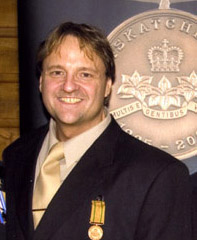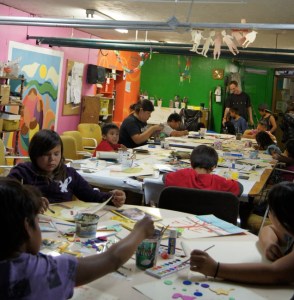Share This
Related Posts
Tags
SCYAP
By Erica Rascón on Jun 5, 2014 in Giving, People
 Since 2001, Saskatoon Community Youth Arts Programming (SCYAP) has offered free visual and graphic arts training to aboriginal youth. Students can chose any of 13 afterschool programs, seven First Nation reserve courses, or attend sessions at SCYAP headquarters. In each setting, the organization provides a safe, encouraging space where youth can hone their art, transforming their raw talent into a source of hope, personal achievement, and income.
Since 2001, Saskatoon Community Youth Arts Programming (SCYAP) has offered free visual and graphic arts training to aboriginal youth. Students can chose any of 13 afterschool programs, seven First Nation reserve courses, or attend sessions at SCYAP headquarters. In each setting, the organization provides a safe, encouraging space where youth can hone their art, transforming their raw talent into a source of hope, personal achievement, and income.
Founder and Executive Director Darrell Lechman holds an extensive background in social services specializing in aboriginal youth. Through SCYAP, he is able to blend his skills as a youth advocate with his enthusiasm for the arts. It’s the perfect fit.
“SCYAP has continued for 13 years because we are passionate about what we do,” says Lechman. But it takes more than passion to undo the effects of 130 years of systematic injustice towards one demographic. That’s why SCYAP uses art to gradually build trust and accountability. Both tools can ultimately lead to youth who are feel valued and are valuable contributors to society.
Over 70% of SCYAP participants are of aboriginal ancestry. These youth face challenges that are unique to their situation: in addition to the barriers of poverty, youth experience prejudice, racism and classism that can result in distrust. In order for SCYAP staff to reach each student, they work consistently to build trust. “Without trust, the program is superficial,” says Lechman.
Simultaneously, SCYAP uses art to instill responsibility and self-worth. Impoverished youth who have two working parents, or a single working parent, may not receive the accountability needed to foster responsibility at home.
“There’s about 60 hours outside of school where kids are with friends or alone,” estimates Lechman. “If we can put them in an environment where they have some guidance, mentorship—where they can be creative and have all the benefits that come with doing art—then we’re putting them in position where they will be more productive and stay out of trouble.”
Students aren’t required to attend art sessions; choosing to participate is the first step of empowerment, demonstrating that they know that their time and talents have better applications than crime, violence, or idleness. With time, students begin to develop a sense of personal value.
SCYAP shows students that their talents can be used to enhance their lives. On a basic level, students develop artistic skills as a positive outlet for their energy. They’re rewarded by the art that they create. During the Urban Canvas program, for example, students’ studies culminate with a mural. “The anti-graffiti programming takes graffiti artists and have them realize there is another venue for their art. They can use their skills and their art style, put in on canvas, murals, and sell their art,” Lechman says. SCYAP students have created 90 art exhibitions, painted over 50 major murals and has created well over 900 pieces of public art since 2002.
The nonprofit also collaborates with local businesses and organization to help highly-skilled students find commissioned work. The organization recently teamed up with local health departments to create and publish a graphic novel. Participants researched public health issues and then created an illustrated novel of prevention methods.
Other students were also selected to make professional signage for local businesses. Participants are paid a percentage of the proceeds. The remainder is funneled back into SCYAP programming. “We want to expand that sort of programing and do more to encourage social enterprise. We’re looking for ways to hire youth that are at-risk, show them the means to be self-sufficient and support the social aspects of SCYAP.”

In order to sustain and grow its programming, SCYAP depends on sponsorships. Yardi contributed to the expansion of Cultural Connections, a program that aims to keep youth in school and use their art to become more civically engaged. Many large gifts help fund art programs but it’s the ongoing financial support—of any size—that ensures SCYAP can see its work through to fruition.
“Our work doesn’t end when an art program ends, or when a class ends. We continue to work with our participants throughout adulthood. I’m often here late and night and early into the AM, working around their work schedules, just being here, being available to talk and help them with whatever they’re going through,” explains Lechman. “After we establish trust, and they can set goals and share them, then we can work with them directly with the challenges that they’ve had through life. We can help them become who they want to be,” says Lechman.
To learn more and show your support, visit scyapinc.org
